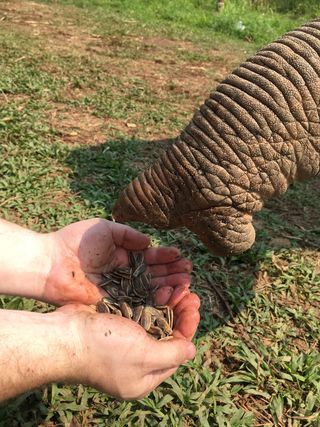Bias
Elephants Smell Out Differences in Quantity
Using only smell, elephants can pick out the larger quantity of food.
Posted June 6, 2019

A new study finds that elephants can discriminate between two quantities of food using only their sense of smell. The study, published in the Proceedings of the National Academy of Sciences, is one of the first to test magnitude discrimination in an animal outside the visual domain.
Many species can tell the difference between more and less when it comes to food, choosing the greater quantity when given the chance, but they have done so based on what they can see. Elephants, however, show mixed results in tests like these. Joshua Plotnik, a comparative psychologist at Hunter College, City University of New York, and the new study’s lead author, thought their performance could be due to the design of the tests.
“Most cognitive experiments that are done with primates or birds use human-centric paradigms that rely on vision,” he says. “If you give an elephant a task that a child or a chimpanzee can solve but the elephant cannot, is it because the elephant isn’t capable or is it because we’re not asking the question in the right way; that is, a way that allows the animal to use its own sensory perspective?”
Elephants do use vision, but it is primarily a complement to their more dominant senses of hearing, smell, and touch. Researchers don’t know a lot about elephants’ sense of smell and how they use it to navigate their environment, but Plotnik thinks it’s possible that they use it when traveling long distances to find food and water. He says that when watching elephants graze, you will often see them put their trunks up in the air like a submarine periscope. They appear to be gathering information with their trunks.
To test whether Asian elephants could distinguish between two quantities of food using only olfactory cues, Plotnik and his colleagues presented the animals with choices between two closed containers containing different ratios of sunflower seeds that the elephants could smell but not see.
The elephants used their sense of smell to choose the larger quantity of food in each pair, regardless of the overall quantity of seeds presented. Their performance was better when the relative difference between two quantities increased and worsened when the ratio between the quantities of food increased, akin to other animals’ performances in visual quantity discrimination tasks. The results show that elephants are able to discriminate between quantities using olfactory information alone.

Plotnik and his colleagues came to this conclusion after performing several different control tests to rule out the possibility that the elephants were using a sense other than smell, acting on inadvertent cues from the experimenters, or responding to unrelated olfactory cues during testing.
This research speaks to a growing push in the field of comparative cognition to design ecologically valid, species-specific experiments – tasks that make sense to the animal being tested.
“We’re not looking to simply compare intelligence; I think that’s an unfair question to ask,” says Plotnik. “Evolution helps animals adapt to the environment in which they live. We’re trying to figure out what sort of cognitive abilities a particular species has and why those capacities have evolved based on what we know about that species.”
Another reason for this research, besides better understanding the evolution of intelligence across species, is to help mitigate human-elephant conflict and support elephant conservation in the wild.
In Asia, the biggest problem facing elephant populations is human-elephant conflict. Human croplands are encroaching on national parks and protected areas, and elephants are leaving protected areas to eat farmers’ crops, like sugarcane and corn. Plotnik says that most of the strategies that have been enacted to prevent this conflict are based on keeping elephants away by scaring them with electric fences or firecrackers. But he says this doesn’t address the root of the problem.
“One thing that’s lacking in these strategies is a focus on the elephant’s perspective,” says Plotnik. “We know what the human perspective is; they want to protect their crops so they can have a livelihood and provide for their families. But what is the elephant’s perspective?
“The bigger picture is to better understand elephant behavior and decision making so we can come up with solutions that satisfy the needs of both humans and elephants.”
References
Plotnik, J. M., Brubaker, D. L., Dale, R., Tiller, L. N., Mumby, H. S., Clayton, N. S. (2019). Elephants have a nose for quantity. PNAS. Doi: 10.1073/pnas.1818284116.


